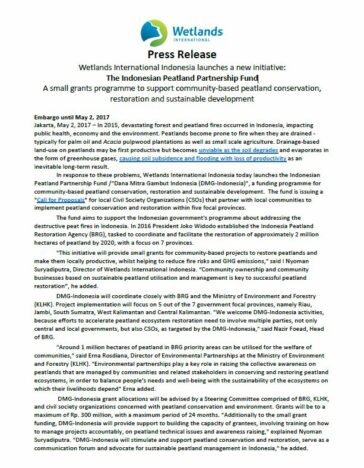
Small Grants Fund for community peatland restoration in Indonesia launched today
Today, Wetlands International launches the Indonesian Peatland Partnership Fund /”Dana Mitra Gambut Indonesia (DMG-Indonesia)” which will support partnerships between local NGOs and communities to restore and sustainably use peatlands. Communities are a key player in peat landscapes and need to be supported with the means to manage their peatlands well, including enhancing awareness and knowledge, learning from experiences around Indonesia and to revive traditional sustainable uses.
Communities traditionally have been using peat swamp forest for their livelihoods. Examples of sustainable uses are the cultivation of Tengkawang (Shorea spp.) for production of edible oil, Jelutung (Dyera spp.) for the production of natural rubber and Sago (Metroxylon spp.) for the production of starch for noodles and cookies. These all grow naturally in Indonesia’s peatlands. There are hundreds of peat swamp plants and trees known for their economic potential. The economical use in plantations on rewetted peat is called paludiculture. Most peatlands in Indonesia are degraded and have been converted into plantations for palm oil and Acacia pulp. Community knowledge on how to manage peatland sustainably is nearly lost and needs to be enhanced.
With the Indonesian Peatland Partnership Fund, communities are given grants to initiate peatland restoration, sustainable management including paludiculture and (business) planning. This will boost the local economy, ownership over resources and knowledge development and will contribute to government-set peatland restoration targets. Wetlands International will facilitate the exchange of knowledge and experiences of grantees and help build the capacity of communities by sharing knowledge on peatland rewetting, restoration and sustainable use.
Current business as usual practices on peatlands require drainage. Drainage-based land-use on plantations peatlands may initially be productive but becomes unviable as the soil degrades. Peatland drainage causes oxidation of the peat soil leading to disproportionally high GHG emissions, fire risks and peatland subsidence. In 2015, the yearly returning fires caused a major haze crisis, hospitalising tens of thousands of people. Losing the peat carbon to the atmosphere leads to peatland subsidence and progressive undrainability, flooding and productivity loss, threatening millions of hectares of peatlands with becoming wastelands in the future.
Community ownership and community businesses based on sustainable peatland utilisation and management is key to successful peatland restoration.
More information
Learn more about Paludiculture (Bahasa Indonesia)
Learn more about IPPF / DMG Indonesia
Learn more about Wetlands International’s global work on peatlands

